Two U.S. Air Force B-1B Lancers flew a presence patrol mission in the Central Region that included several partner nation air forces Nov. 11, 2021.
RED SEA
11.11.2021
Video by Senior Airman Colin Hollowell
United States Air Forces Central
Two U.S. Air Force B-1B Lancers flew a presence patrol mission in the Central Region that included several partner nation air forces Nov. 11, 2021.
RED SEA
11.11.2021
Video by Senior Airman Colin Hollowell
United States Air Forces Central
By Pierre Tran
Paris – The US state department has given the green light for the sale of electromagnetic aircraft catapults and arresting gear, worth an estimated $1.3 billion, for a French next-generation aircraft carrier, the Defense Security Cooperation Agency said.
“The State Department has made a determination approving a possible Foreign Military Sale to the government of France of Electromagnetic Aircraft Launch System (EMALS),
Advanced Arresting Gear (AAG), and related equipment for an estimated cost of $1.321 billion,” the agency said in a Dec. 21 statement.
A required notification to the US Congress for the sale was delivered Dec. 21, the agency said. France has requested procurement of one electromagnetic system with two launchers and one advanced arrestor gear, in a three-engine configuration.
The Direction Générale de l’Armement was now waiting for the US Congress to approve the deal, a spokeswoman for the DGA French procurement office said.
“This is excellent news,” said navy captain Eric Lavault, spokesman for the French service. “This is what we were looking for.”
The prime contractors will be General Atomics-Electromagnetic Systems and Huntington Ingalls, the agency said. There will be no offset deal on the deal, which calls for some 40 US government officials and contractors to spend 10 weeks a year in France, from 2033 to 2038 to support installation, certification, and sea trials.
“This proposed sale will support the foreign policy and national security of the United States by helping to improve security of a NATO ally which is an important force for political stability and economic progress in Europe,” the agency said.
“The proposed sale will result in continuation of interoperability between the United States and France,” the agency said, with the electromagnetic catapults and arrestor gear to be installed on the French next-generation aircraft carrier.
“France will have no difficulty absorbing this equipment into its armed forces,” the agency said. The prospective deal includes land-based testing, installation, training, service, and spares.
From an operational view, the electromagnetic system delivers a Catapult Assisted Take-Off But Arrested Recovery (CATOBAR) capability, allowing the planned next-generation fighter and Rafale fighter jets to carry more weapons and more fuel – to fly greater distance – than fighters flying off ski-jump carriers, a French source said.
The British fleet air arm flies the F-35 fighter in its vertical and short take-off and landing (VSTOL) version. The F-35 takes the Short Take-Off But Arrested Recovery (STOBAR) approach on the ski-jump deck on the Royal Navy’s Queen Elizabeth carrier.
“You can’t compare,” the source said, pointing up the differences between the two ship designs.
There is growing interest in catapults, with China building a catapult on its third carrier, project name 003, the source said, while the Indian navy has shown interest in building a third carrier equipped with catapults, rather than the ski jumps on its first two vessels.
For the French navy, the electromagnetic catapults will allow a higher operational tempo, the source said, allowing more launches of heavy aircraft – such as a planned new fighter carrying nuclear weapons – and lighter remote carriers or combat drones. The arrestor gear will bring less stress on the aircraft landing gear.
The new fighter will be a key element of the European Future Combat Air System.
There will be continuity as the Charles de Gaulle carrier uses US-built catapults, the source said. The French fleet air arm flies the Rafale, which can carry nuclear weapons, off the nuclear-powered capital ship, which carries a US navy officer to oversee the catapults.
The testing of the electromagnetic system on the US navy’s Gerald Ford carrier meant the French service would be acquiring a “sea proven” catapult, the source said, adding that if France developed its own system, that would cost more.
The Charles de Gaulle vessel is due to retire in 2038, so the new 75,000-tonne carrier is expected to enter service around that time. The new nuclear-powered carrier is expected to carry some 30 fighters, which would combine the Rafale and the new fighter.
The new carrier will be a “strategic asset indispensable for France,” said a video produced by the French navy and the DGA.
EMALS Launch USS Gerald R. Ford, November 17, 2020 from SldInfo.com on Vimeo.
ATLANTIC OCEAN (Nov. 15, 2019) Chief Aviation Boatswain’s Mate (Equipment) Louis Mountain Jr., from Seat Pleasant, Maryland, assigned to USS Gerald R. Ford’s (CVN 78) air department, signals the electromagnetic aircraft launch system (EMALS) to launch during no load testing on the ship’s flight deck. This was the first test of Ford’s EMALS since the end of its post shakedown availability. (U.S. Navy photo by Mass Communication Specialist 3rd Class Zachary Melvin)
Fighter aircraft participating in Checkered Flag 22-1 relieve air refueling from a KC-10 Extender assigned to the 79th Air Refueling Squadron, Travis Air Force Base, California, over the Gulf of Mexico, Nov. 8, 2021.
11.08.2021
Video by Staff Sgt. Betty Chevalier
325th Fighter Wing Public Affairs
According to a November 18, 2021, story by LCpl Michele Clarke, 2nd MAW recently worked practiced F-35B operations working with a forward arming and refueling point.
The Marines are working to enhance their capabilities to operate the force from a variety of remote locations to support its capability to operate as an effective distributed force.
Subordinate units of 2nd Marine Aircraft Wing (MAW) conducted a demonstration of a forward arming and refueling point and air delivered ground refueling (ADGR), which are part of the expeditionary advanced base operations (EABO) and future operating concept at MCALF Bogue, North Carolina, Nov. 18, 2021.
The event was a demonstration of EABO concepts to illustrate the capabilities of 2nd MAW as a result of the Commandant of the Marine Corps’ force design. The demonstration marks the first occasion of ADGR of an F-35B on the East Coast, and the first time 2nd MAW has conducted F-35B operations at MCALF Bogue.
“One of the things that was unique today was it is the first time the F-35B [assigned to 2nd MAW], the Marine Corps variant, came to Bogue field in any capacity; and then in addition, we’re able to gain a lot of extra training value by conducting an ADGR, for the KC-130 crews as well as the F-35 ordnance Marines and pilots,” said Maj. Anthony Walters, a KC-130J pilot with Marine Aerial Refueler Transport Squadron (VMGR) 252.
Expeditionary advanced base operations is part of the Commandant of the Marine Corps’ force design 2030 concept to enable Marines to become even more mobile, lethal, and to make it harder for the enemy to detect them. The demonstration involved multiple units within 2nd MAW to showcase the capabilities to II Marine Expeditionary Force commanders and staff.
“The most important aspect of an event like we executed today at Bogue field is to inform and enable our future decision makers that came down to observe the event from MEF on how to employ the EABO concepts so they understand the mitigating factors and the timelines associated to better understand how that fits into their overall war plan,” said Walters.
In addition to being the first F-35 ADGR training event on the East Coast for 2nd MAW, the last time this event took place for Marine Corps F-35Bs was at the Weapons Tactics Instructor course at Marine Corps Air Station Yuma, Arizona. The training event and demonstration validated 2nd MAW’s capabilities and proficiency to execute Marine Corps aviation tasks in support of the Commandant’s vision of the future force and operating concepts.
The next book in our Second Line of Defense Strategic Book Series which will appear in the first quarter of 2022 focuses on the USMC transformation process underway from 2007.
AKR4607 US-Trade-Soft-Cover~BBP-Cover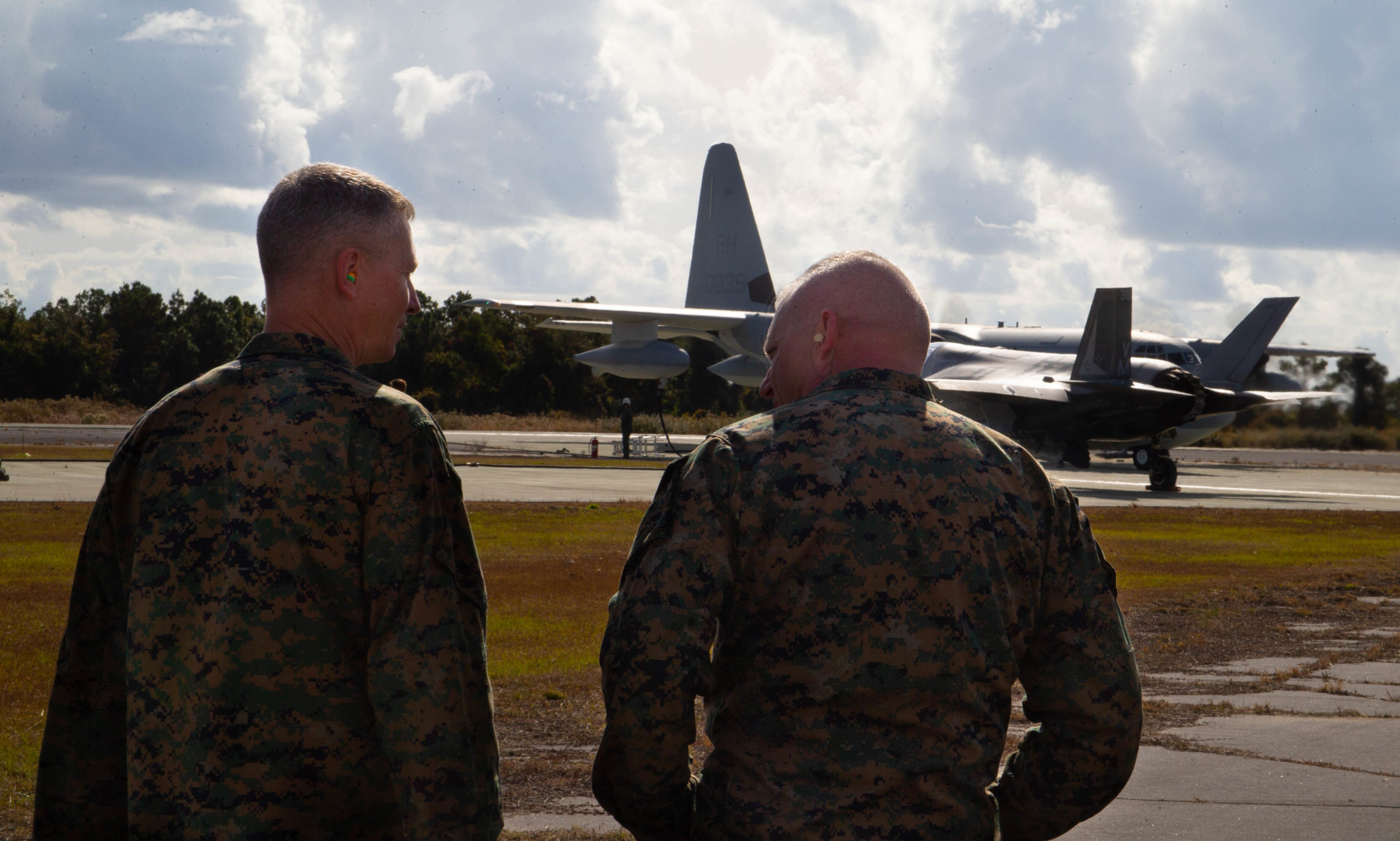
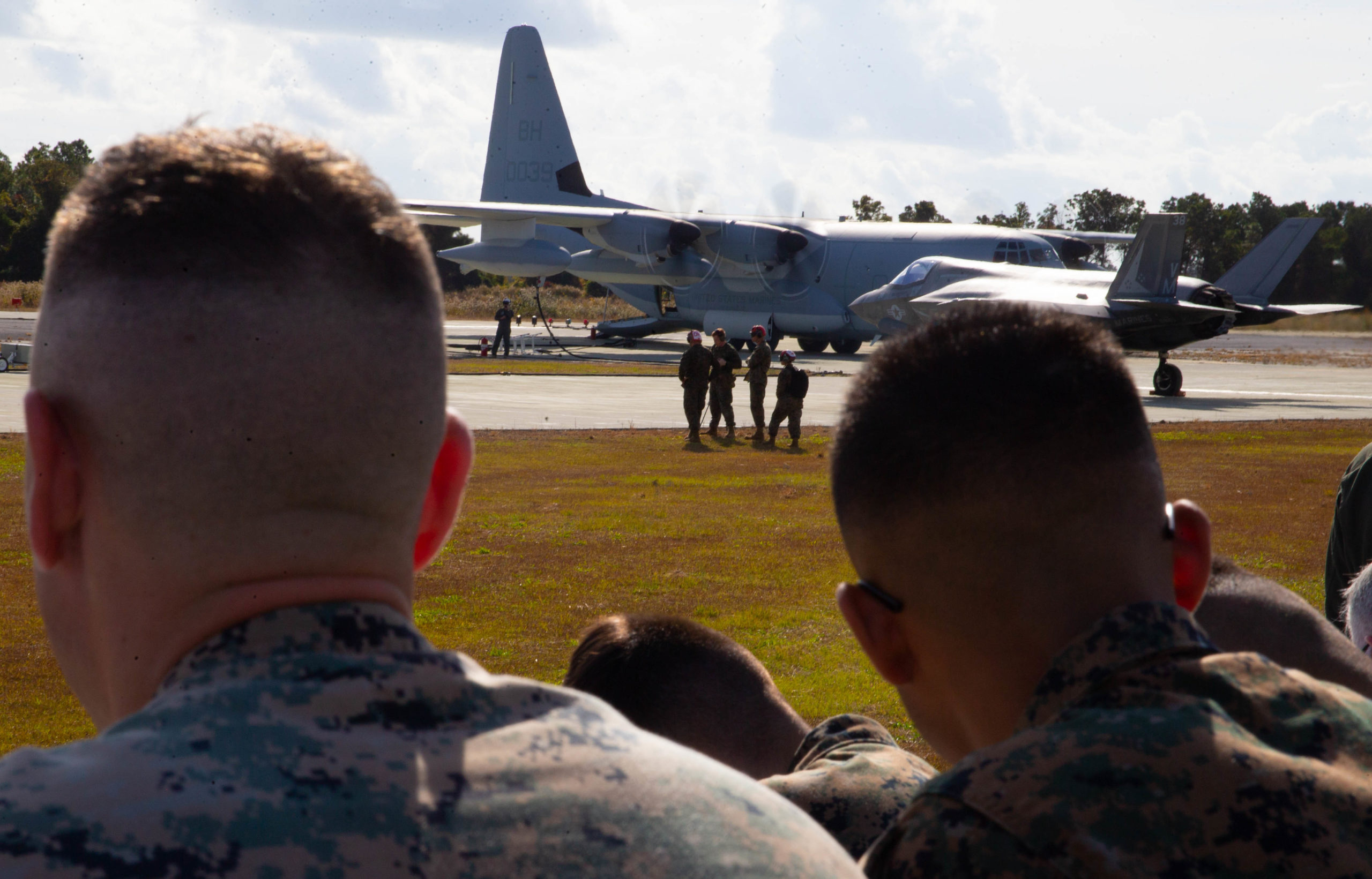
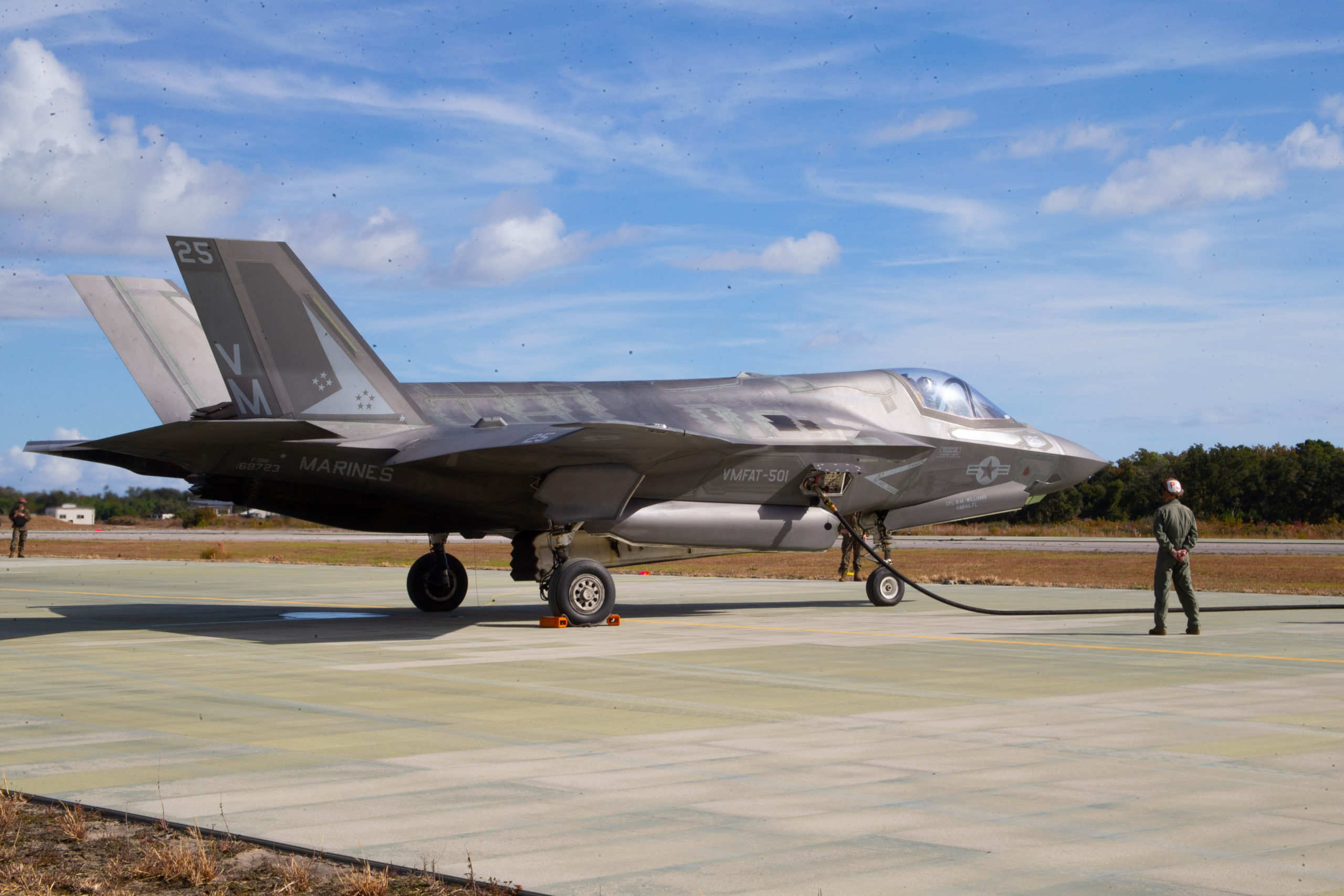
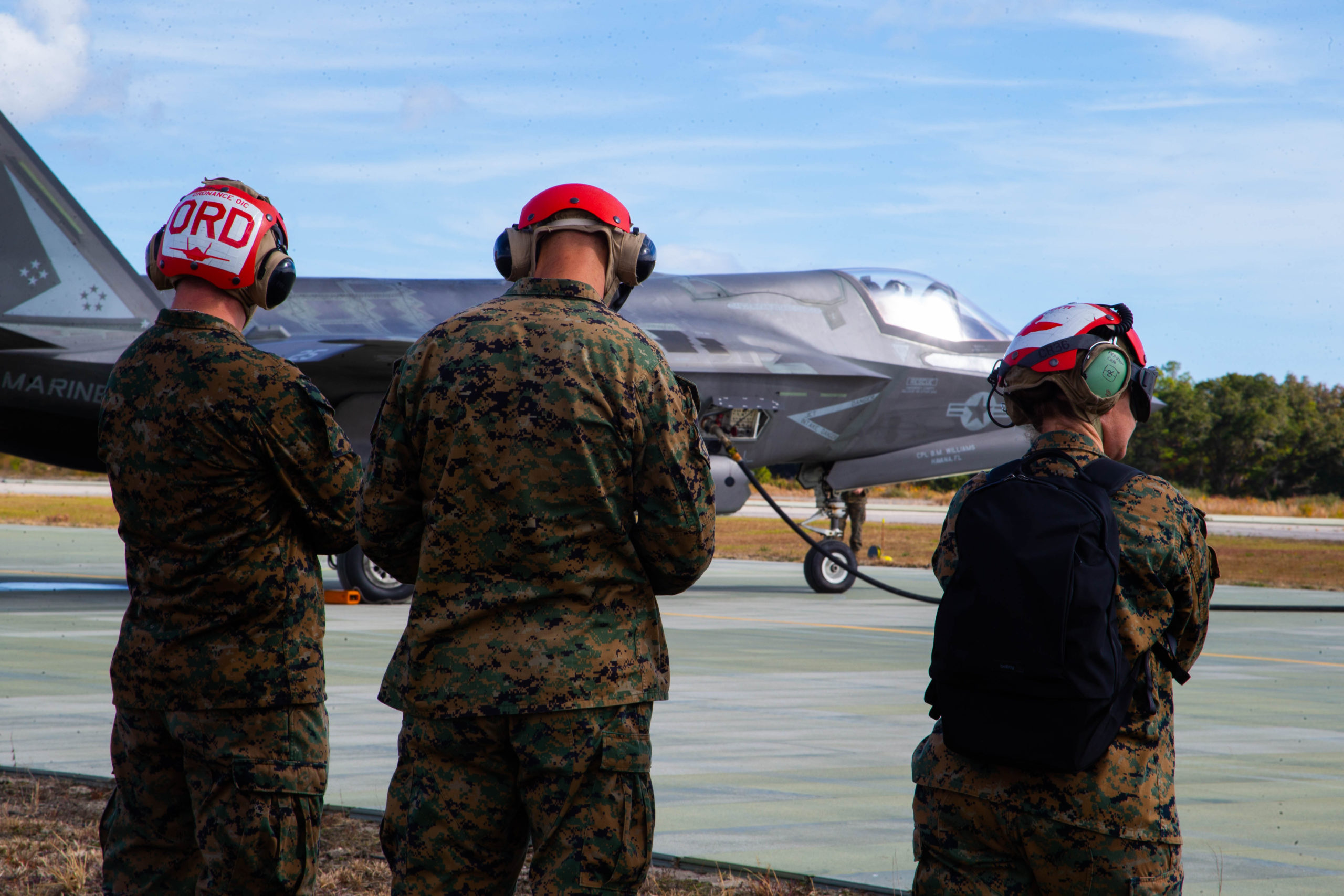
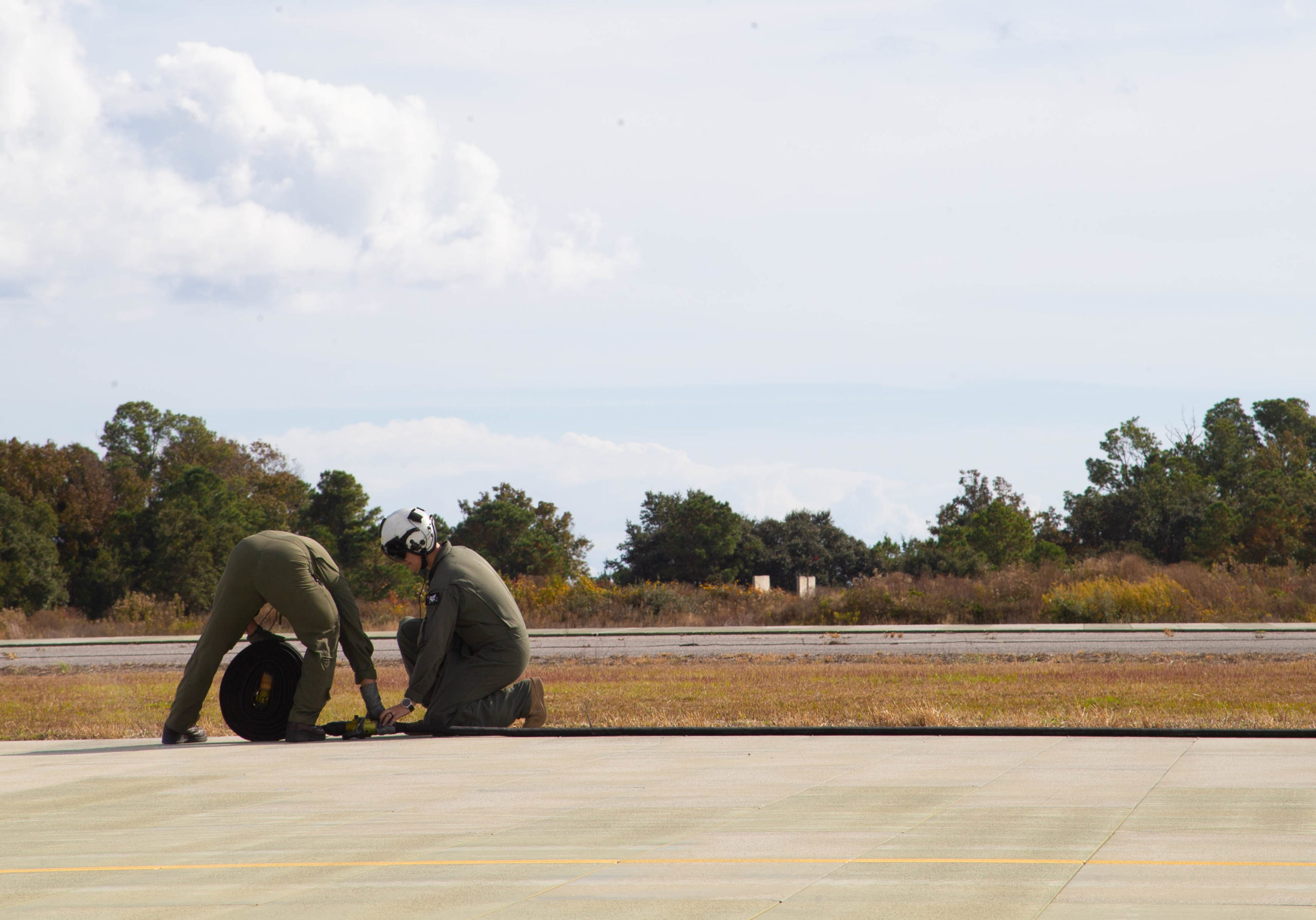
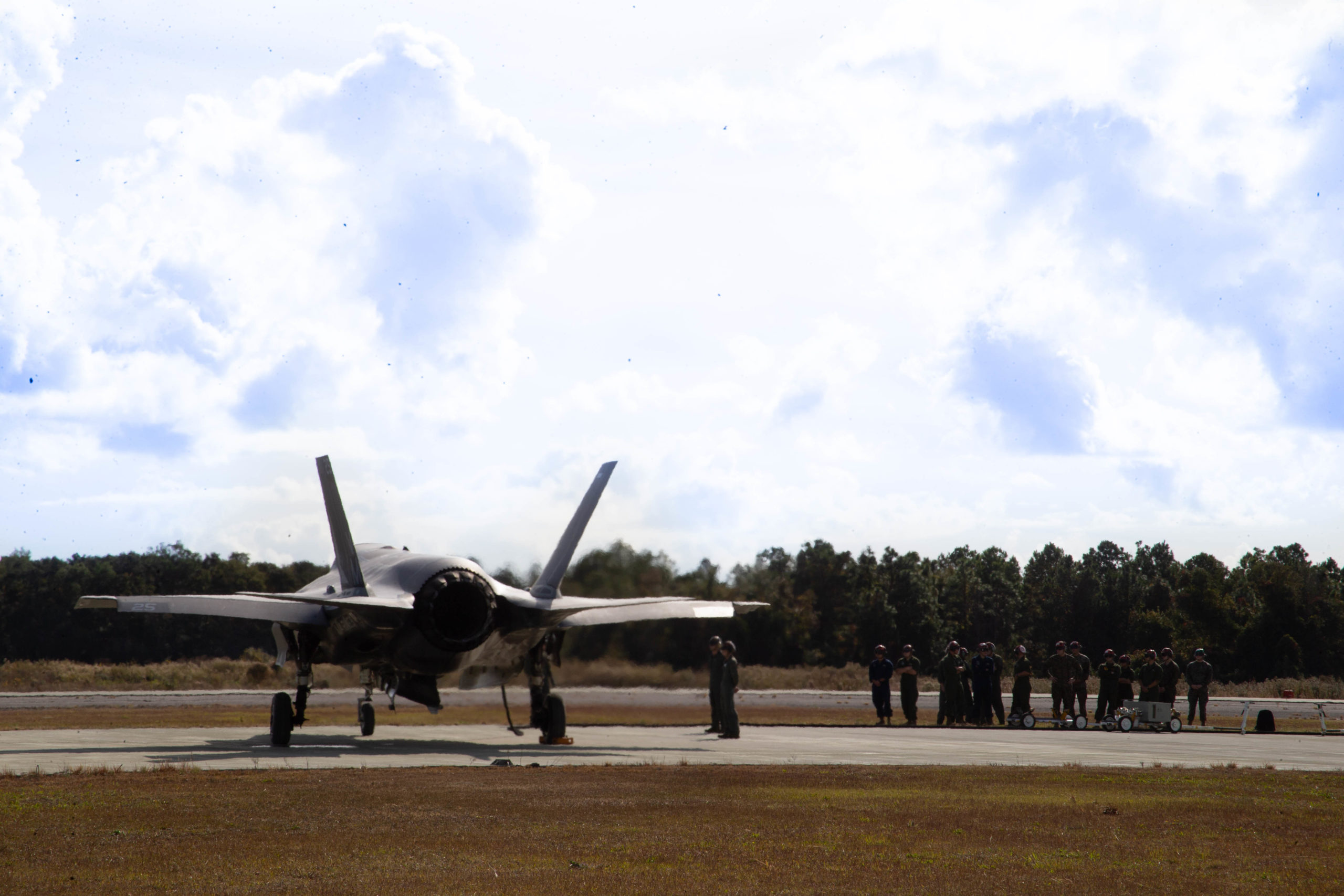
During our visit to II MEF last summer, the CG of II MEF, LtGen Beaudreault highlighted the importance of agreements between 2nd ESG and II MEF to work more closely together.
Recently, the two commands held a joint war-fighting symposium to do precisely that.
According to a USMC press release from November 15, 2021, this effort was highlighted.
U.S. Marines with 2d Marine Expeditionary Brigade , II Marine Expeditionary Force, hosted a Naval Warfighting Symposium for Expeditionary Strike Group Two , U.S. 2nd Fleet, on Marine Corps Base Camp Lejeune, Nov. 3, 2021. This exchange was an opportunity enhance joint capabilities between services.
During the symposium, Marines and sailors conducted joint briefings on their capabilities as an integrated team and collaborate on further integration.
“Each staff member brings different capabilities to the fight, and being able to highlight those key points between each speaker shows their value,” said U.S. Marine Corps Maj. Eric Fleegle, a future operations planner with G-4, 2d MEB.
The symposium not only promotes integration between Navy and Marine Corps, but also contributes toward mission accomplishment with partners and allies.
“I put on my NATO hat and looked at the talks from that outside perspective,” said Dutch Lt. Cmdr. Dirk De Beurs, an exchange officer from the Netherlands with ESG-2. “Whenever U.S. Forces are in Europe, they have NATO partners and countries that can also support them.”
U.S. Navy Rear. Adm. John Meloni, the commander of ESG-2, said one of his guiding points was understanding culture.
“You can’t have a truly integrated force without having a culture that values the input of others and understands there is a chain of command, but treat everyone appropriately so that they can do their jobs,” said Meloni.
The integration between the Navy and Marine Corps has never been more critical for success in the littorals, coast and by the sea.
Featured Photo: U.S. Marines with 2d Marine Expeditionary Brigade, II Marine Expeditionary Force, pose for a group picture with Sailors with Expeditionary Strike Group Two, U.S. 2nd Fleet, after a Naval Warfighting Symposium on Marine Corps Base Camp Lejeune, Nov. 5, 2021.
This event was an opportunity to bring together both 1-star commands and provide a venue to gain a better understanding of one another’s capabilities. During the symposium, Marines and Sailors conducted integrated briefings relating to their roles in an integrated environment or on how they could move towards that common ground. To go further in immersing the service members, discussion groups were held after the briefing to have a more personal conversation amongst peers from their respective operational areas.
(U.S. Marine Corps photo illustration by Sgt. Jesus Sepulveda Torres/Automation)
Aircrew members assigned to the 340th Expeditionary Air Refueling Squadron operate a U.S. Air Force KC-135 Stratotanker, deployed to Al Udeid Air Base, Qatar, to conduct aerial formation with U.S. Air Force B-1B Lancers, Israeli Air Force F-15s, Royal Saudi Air Force F-15s and U.S. Air Force F-16 Fighting Falcons above U.S. Central Command’s area of responsibility, Nov. 11, 2021.
QATAR
11.11.2021
Video by Staff Sgt. Frank Rohrig
United States Air Forces Central
By Pierre Tran
Paris – UK prime minister Boris Johnson needs to face up to geopolitical reality and forge strong links with the European Union, and accept Global Britain is little more than a “title in search of a plot,” said a report from the European Council on Foreign Relations, a think tank.
Johnson would do well to work with the EU, an important geographical neighbor, rather than rely on notions of a national identity forged from former greatness, said the report, titled Beyond Global Britain: A Realistic Foreign Policy for the UK.
A “preoccupation with the second world war,” exemplified by when the UK stood alone in 1940, underpinned the Brexit campaign, but denied the economic reality of a forecast four percent drop in gross domestic product due to leaving the EU, the report said.
The ECFR report was presented here Dec. 16 at a seminar with French government officials, European diplomats, and officials of French think tanks.
Meanwhile, Johnson’s Conservative party took Dec. 19 a resounding hit with the unexpected resignation of David Frost, a minister charged with negotiating with the EU in the wake of Brexit, reported to be “the prime minister’s man.”
Frost resigned in dispute with government policy on anti-Covid measures and tax increase, with foreign minister Liz Truss taking up the Brexit brief.
That departure of a top negotiator with the EU followed a political setback for Johnson, with the Dec. 16 defeat of the Conservative party in a parliamentary by-election. A Liberal Democrat candidate won with a 34 percent electoral swing a parliamentary seat previously held almost 200 years by the Conservatives.
Johnson had “one more strike,” said a senior Conservative parliamentarian, as that local election had been a referendum on the prime minister seen to be leading a government mired among political charges of alleged corruption and deceptions, including Christmas parties held last year at Downing Street, the office of the prime minister, when a lock down forbade social events.
Such setbacks are seen as weakening Johnson, who won his dream job on pledges he would unshackle Britain from the Brussels bureaucracy and deliver a great and sovereign nation.
Johnson’s Global Britain approach holds little place for the EU, the ECFR report said.
“The Johnson government seems to need perennial fights of a permanent Brexit, but this approach is eroding the UK’s capacity to cooperate with the EU on foreign and security policy,” said the authors, Jeremy Shapiro, research director, and Nick Witney, senior research fellow.
“Brexit has become more an ideology than a policy,” the report said. “But the ideology of permanent Brexit cannot suspend the laws of distance and strategy. The UK may have left the EU, but it cannot leave Europe.”
Meanwhile, the U.S. is “self-absorbed” and looks to the Indo-Pacific and China, the report said. The UK would do well to work with the EU as an alternative to being junior partner in a special relationship that London claimed with Washington.
The UK would benefit from a balanced relationship with the EU and the U.S. in a triangle, the report said, rather than depend on goodwill of the latter.
“The best way to protect British interests is to triangulate between the EU and U.S. positions, the report said.
“The UK defense establishment remains deeply committed to America,” Witney said. “The aircraft carriers and, indeed the Royal Navy, often resemble subsidiaries of the U.S. navy.”
On the trilateral AUKUS agreement between Australia, the UK and the U.S., the report said the U.S. navy has great reluctance to share its nuclear propulsion technology, and U.S. and British nuclear power plants have evolved in significantly different ways since 1958 when the U.S. service shared its know-how with the UK.
The U.S. might prefer the British to supply nuclear propulsion for the Australian boats to protect their “doubtlessly more advanced” technology, the report said.
That AUKUS pact, which aims to pave the way for Australia to acquire nuclear-powered submarines, damaged close Anglo-French ties. The trilateral partnership led to Canberra canceling a plan to build French-designed diesel-electric boats for the Australian navy, a deal estimated to be worth some €30 billion ($34 billion).
As a result, France has put a hold on links with the UK, with Paris postponing assessment studies for European missile maker MBDA on the Future Cruise/Anti-Ship Weapon project.
French political support is needed for the study to go ahead, a source close to the deal said, while industry is ready.
The assessment study would seek to lower risk and look at concepts for increased stealth and greater speed for the missile, which would replace the Harpoon anti-ship weapon for the Royal Navy and Exocet for the French navy, as well the Scalp/Storm Shadow cruise missile for respectively French and British air forces.
The Royal Navy has put on hold a planned order for an interim weapon to plug a capability gap after retirement of the Harpoon in 2023 and the entry into service of FC/ASW in 2030. Time was needed to consider the long term prospects for FC/ASW, which could feature a hypersonic missile, rather than rush an order for an interim solution, Admiral Tony Radakin said, UK Defence Journal reported Nov. 6.
MBDA executive chairman Eric Béranger said March 31 the launch of assessment work on FC/ASW was one of the key events of this year, pointing up the importance of the 2010 Anglo-French Lancaster House treaty on cooperation in the arms industry.
The UK’s military aerospace sector is a “key economic asset,” the ECFR report said, but much rides on the Tempest next generation fighter jet and whether it can compete with “a better-funded and more advanced effort conducted by France, Germany, and Spain.”
The British pursuit of the Tempest, partnered with Italy and Sweden, and the Future Combat Air System being developed by France, Germany and Spain are “a grotesque waste of European resources,” Witney said, pointing to a future repeat of competition between the Rafale and Eurofighter, and the prospect of two future European fighters.
On the FCAS project for a next generation fighter, the French armed forces minister, Florence Parly, told Dec. 14 the defense committee of the lower house National Assembly a contract for a technology demonstrator for the new fighter was expected to be signed in the first half of 2022.
“There are still some issues to be resolved,” she said. The main issue was there should be a prime contractor on specific domains, with a clear set of responsibilities for the contractor.
A demonstrator was expected to fly in 2027, she said, which might appear far off, but in reality there was little time as there was much work to be done.
Agreement was needed to sign contracts to launch phases 1b and 2 on the demonstrator, with a budget reported to be worth some €3.5 billion ($4 billion), funded by the three partner nations.
The Sunday Times, a British paper, reported Nov. 20 senior aides of Johnson were drawing up plans for extending cooperation with France beyond the Lancaster House treaty, a new Entente Cordiale, to include nuclear testing, fighters flying from each other’s aircraft carriers, and cooperation in the Indo-Pacific region.
That article met with skepticism from French think tank officials at the ECFR seminar, pointing up that these ideas were not directly from Johnson and there had been little further press coverage.
Britain and France could not afford to wait until after the French April elections to hold talks, Georgina Wright, senior fellow and director of the Europe program at Institut Montaigne, said in a Nov. 24 article for the French think tank.
Both countries suffered from a lack of bilateral cooperation yet shared similar world views, she said. The U.S. and other partner nations expected the two countries to work together in their own region and elsewhere in the world.
“Complex geopolitical problems cannot afford strategic patience,” she said.
The AUKUS agreement made France more strategically alone, she said, and while the deal helped Britain in its Global Britain approach, more was needed to convince countries of the UK’s new role in the world.
“Finally, the longer the UK and France wait to hold talks, the more the gap will widen,” she said.
There have been no Anglo-French summits for two years, with political ties worn thin from tension arising from the new normal of post-Brexit disputes, including fishing rights in the Channel and trade across the border between Northern Ireland and the Republic of Ireland.
The next high-level meeting might take place late next year, as time was needed for a new French administration to settle down after the April elections, think tank officials said at the ECFR seminar. There was little chance of a summit before then, as president Emmanuel Macron prepared for the upcoming elections.
The ECFR report, with opinion polls conducted by Datapraxis, showed the EU was seen as the UK’s most important partner, with 39 percent of respondents in favor of the EU, followed by 22 percent for the US, and six percent for Australia. China drew three percent, and Australia one percent.
Of allies and necessary partners, Australia led the field for allies with 61 percent and 18 percent for necessary partner; 34 pct saw the U.S. as ally and 43 percent as necessary partner, followed by Germany with 28 percent ally, 37 percent necessary partner. Twenty two percent saw France as ally, 36 percent as partner, while India drew18 percent as ally, 41 percent partner.
“Global Britain is a delusion,” the ECFR report concluded.
“But there is a foreign policy that can command the support of the British public and map out a secure and influential future for the UK. The real question is whether the British people will find a government with the wit and the will to seize the future.”
Featured Graphic: Photo 119099644 / Britain European Union © Florin Seitan | Dreamstime.com
USS America (LHA 6), the Navy’s only forward-deployed amphibious assault ship, docks at the harbor at Marine Corps Air Station Iwakuni, Japan, Nov. 18, 2021.
Due to its geographic location and co-located airfield and harbor, MCAS Iwakuni is uniquely postured to provide advanced naval integration in support of regional security,
IWAKUNI, YAMAGUCHI, JAPAN
11.18.2021
Video by Cpl. Evan Jones AFN Iwakuni